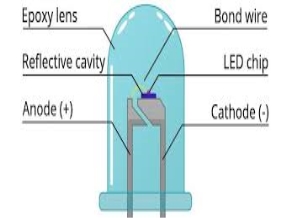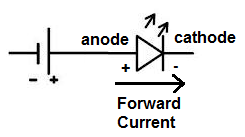Unit – 2
Semiconductor Light Emitting Diodes
Question and answer
1) What is rate equation for carrier Density?
Answer:
The LED rate calculations are derived from the continuity equations as applied to the p-n diode:
 =
=  – R+ G
– R+ G
Now,
G is the generation, generation rate per unit volume (V)
R is the recombination, Recombination rate per unit volume (V)
2) Radioactive And Non-Radioactive Recombination Mechanisms In Semiconductor?
Answer:
Radioactive electron-hole recombination;
Using law of mass action- product of hole and electron at constant temperature at equilibrium condition,
n0p0 = n2i
n0- equilibrium electron concentration
p0- equilibrium hole concentration
ni- intrinsic carrier concentration
Total carrier concentration = equilibrium + excess carrier concentration i.e.
n =n 0 + n or p = p 0 + p
So, recombination is directly proportional to hole then electron i.e.
R np
R =  =
=  = Bnp
= Bnp
The above equation known as biomolecular rate equation, and B is a constant named biomolecular recombination coefficient ,where value lies between 10 – 11 – 10 – 9 cm 3/s for semiconductor.
Non-Radioactive Recombination
In non-radioactive recombination, the electron energy is transformed to vibration energy of lattice atoms, i.e. phonons.
Thus, the electron energy is transformed to heat.
Defects in the crystal structure takes place maximum common cause for non-radioactive recombination events .
This properties cause of unwanted foreign atoms, native defects, dislocations.
Trap-assisted recombination occurs- when an electron falls into a “trap”, this is an energy level within the band gap caused by the presence of a foreign atom or a structural defect.
Another electron not accepted once the trap is filled.
The electron occupying the trap, in a second step, falls into an empty valence band state, thereby finishing the recombination process.
If we assume p-type semiconductor, i.e. the holes are in majority p0 >> n0, and we undertake small deviation from equilibrium, i.e. ∆n << p0 then minority carrier lifetime is would be
 =
=  =
= 
If the electrons were majority carriers, the lifetime converts:
 =
=  =
= 
3) Define: LED. Give characteristics. Draw a suitable figure. Explain which material required for forming LED?
Answer:


Definition : A light Emitting Diode (LED) is an optical semiconductor device that emits light when voltage is applied. In other words, LED is an optical semiconductor device that converts electrical energy into light energy.
LED Materials :
The main semiconductor materials used to manufacture LEDs are: Indium gallium nitride (InGaN): Blue, Green and Ultraviolet high-brightness LEDs.
Aluminum gallium indium phosphide (AlGaInP): yellow, orange and red high-brightness LEDs.
Aluminum gallium arsenide (AlGaAs): red and infrared LEDs.
Characteristics of LED:
Polarity of LED:

Forward Current LED:

Forward Voltage of LED:

LED can Generate Different Light Color
Temperature(T) will Affect LED Efficacy
Low Energy Consumption
Long Life
4) State figure of merit?
Answer:
LEDs are very energy efficient and consume up to 90% less power than incandescent bulbs.
Since, LEDs use only a fraction of the energy of decrease in power costs.
Also, money and energy is saved in keep and replacement costs due to the long LED lifespan.
LEDs have a lifespan of up to 60,000 hours compared to 1,500 hours for incandescent bulbs.
Rate Equations for Carrier Density N:
 =
=  -
-  – GS
– GS
Here , is pump injection of carriers
is pump injection of carriers
 is recombination of carriers
is recombination of carriers
GS Stimulated emission and absorption
Rate Equations for Photon Density S:
 = GS -
= GS -  +
+ 
 GS is stimulated emission absorption
GS is stimulated emission absorption
 is cavity losses
is cavity losses
 is spontaneous emission
is spontaneous emission
Steady state solutions with sp=0;
 ;
;  ( LASER OFF)
( LASER OFF)
 ;
;  (LASER ON)
(LASER ON)